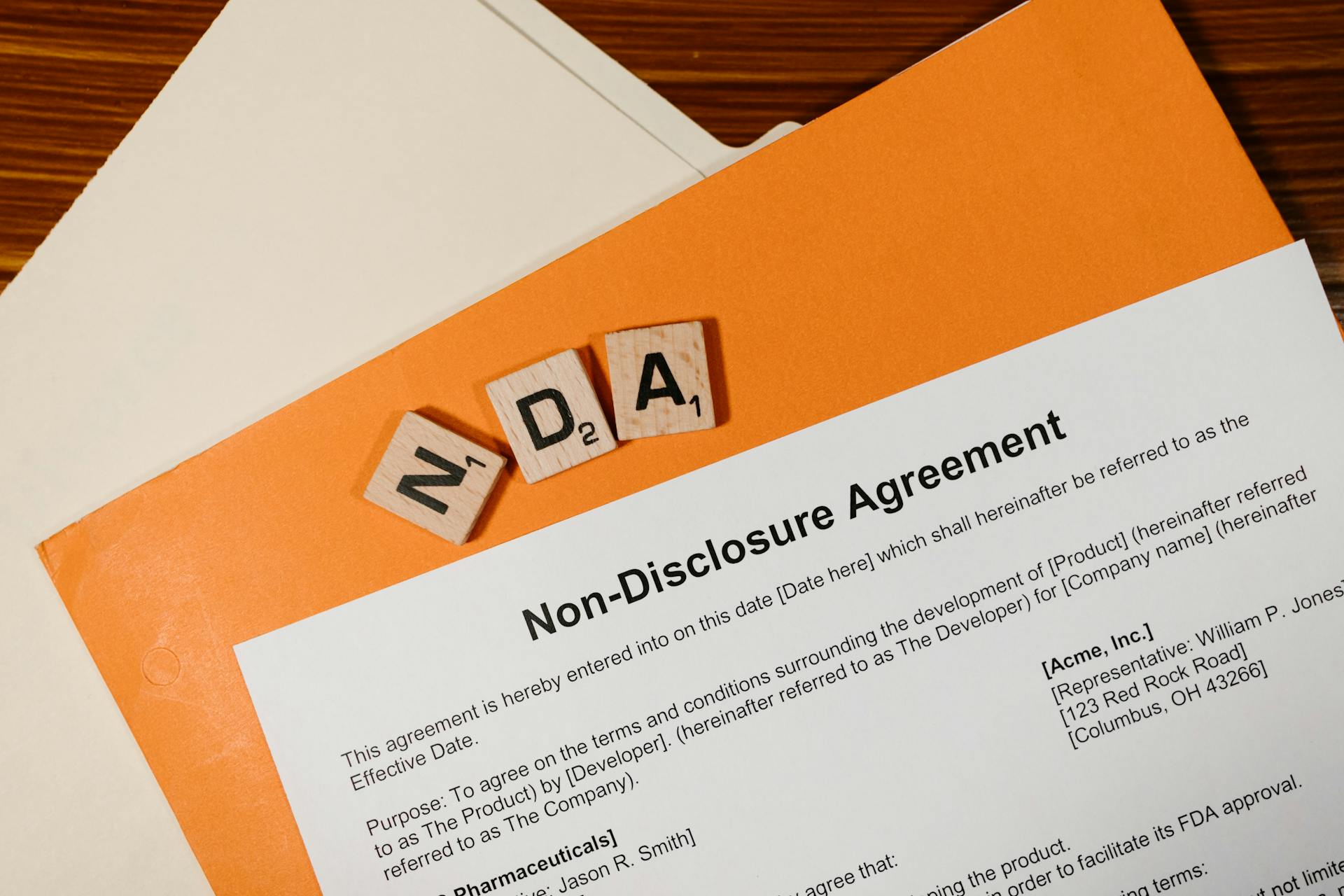
Implementing HIPAA regulations requires a thorough understanding of the rules and guidelines. HIPAA (Health Insurance Portability and Accountability Act) is a federal law that protects the confidentiality, integrity, and availability of protected health information (PHI).
To ensure compliance, covered entities must implement administrative, technical, and physical safeguards. This includes conducting a risk analysis, implementing policies and procedures, and providing training to workforce members.
HIPAA sets a standard for electronic health records (EHRs) and requires covered entities to implement security measures to protect PHI.
Curious to learn more? Check out: Who Is Responsible for Implementing and Monitoring the Hipaa Regulations
Administrative Requirements
Administrative Requirements are a crucial part of HIPAA implementation. A Covered Entity or Business Associate must implement Administrative Safeguards to protect electronic Protected Health Information (ePHI). This includes identifying a security official responsible for developing and implementing policies and procedures.
To ensure workforce security, all members must have appropriate access to ePHI, and unauthorized members must be prevented from accessing it. This is achieved through role-based access management. Regular security awareness training is also required, covering periodic security updates, malware detection and reporting, login monitoring, and password creation and safeguarding.
Curious to learn more? Check out: Hipaa Access Control
Covered Entities must also implement policies and procedures to comply with the standards, implementation specifications, or other requirements of this subpart. These policies and procedures must be written, reasonable, and appropriate, taking into account factors such as size, complexity, and capabilities, technical infrastructure, and costs of security measures.
The documentation of these policies and procedures is essential. Covered Entities must maintain written records of required actions, activities, or assessments for six years after their creation date or last effective date, whichever is later. This documentation must be available to those responsible for implementing the procedures.
General Rules
Covered Entities and Business Associates must ensure the Confidentiality, Integrity, and Availability of all ePHI that they create, receive, maintain, or transmit.
To protect ePHI, Covered Entities must protect against any reasonably anticipated threats or hazards to the Security or Integrity of such ePHI, and against any reasonably anticipated uses or disclosures of such ePHI that are not permitted or required under 45 CFR §§ 164.500 – 164.534.
If this caught your attention, see: How Does Hipaa Protect
Covered Entities must also ensure compliance with these requirements by their workforce.
To implement security measures, Covered Entities must consider their own needs and specific environments. This includes taking into account their size, complexity, and capabilities, as well as their technical infrastructure, hardware, and software security capabilities.
The costs of security measures and the probability and criticality of potential risks to ePHI must also be considered.
Covered Entities must adopt, maintain, review, and update policies and procedures that are written, reasonable, and appropriate. These policies and procedures, along with written records of required actions, activities, or assessments, must be maintained for six years after their creation date or last effective date, whichever is later.
Here is a summary of the requirements:
Administrative Requirements
A Covered Entity or Business Associate must implement policies and procedures to ensure the confidentiality, integrity, and availability of ePHI.
To comply with the Security Rule, a Covered Entity or Business Associate must ensure that its workforce members have appropriate access to ePHI and prevent unauthorized workforce members from obtaining access to ePHI.
Discover more: Hipaa Business Continuity
Workforce Security is a key component of Administrative Safeguards, which requires a Covered Entity or Business Associate to ensure that all workforce members have appropriate access to ePHI.
A Covered Entity or Business Associate must implement training for all workforce members that addresses periodic security updates, procedures for malware detection and reporting, and procedures for monitoring logins.
Security Awareness and Training is a critical aspect of Administrative Safeguards, which requires a Covered Entity or Business Associate to implement training for its workforce members.
A Covered Entity or Business Associate must identify and respond to suspected or known security incidents, mitigate harmful effects, and document security incidents and their outcomes.
Security Incident Procedures is a key component of Administrative Safeguards, which requires a Covered Entity or Business Associate to identify and respond to suspected or known security incidents.
A Covered Entity or Business Associate must ensure that its policies and procedures are written, reasonable, and appropriate, and that they are maintained for six years after their creation date or last effective date.
A Covered Entity or Business Associate must maintain written records of required actions, activities, or assessments for six years after their creation date or last effective date.
Here is a list of the Administrative Safeguards required by the Security Rule:
- Security Management
- Security Responsibility
- Workforce Security
- Information (ePHI) Access Management
- Security Awareness and Training
- Security Incident Procedures
- Contingency Plans
- Evaluation
Physical Security
Physical security is a crucial aspect of HIPAA implementation. A covered entity or business associate must implement policies and procedures to limit physical access to its electronic information systems and the facility or facilities in which they are housed.
Properly authorized access must be allowed, and procedures must be established to support restoration of lost data under the disaster recovery plan and emergency mode operations plan in the event of an emergency. This includes implementing procedures that allow facility access in support of restoration of lost data under the disaster recovery plan and emergency mode operations plans.
The facility security plan must be implemented to safeguard the facility and the equipment therein from unauthorized physical access, tampering, and theft. This includes implementing policies and procedures to control and validate a person's access to facilities based on their role or function.
Access control and validation procedures must be implemented to control and validate a person's access to facilities, including visitor control, and control of access to software programs for testing and revision. Maintenance records must be implemented to document repairs and modifications to the physical components of a facility which are related to security.
Recommended read: Hipaa Security Services
A covered entity or business associate must implement physical safeguards for all workstations that access electronic protected health information, to restrict access to authorized users. This includes implementing policies and procedures that govern the receipt and removal of hardware and electronic media that contain electronic protected health information into and out of a facility.
The final disposition of electronic protected health information, and/or the hardware or electronic media on which it is stored, must be addressed through policies and procedures. This includes procedures for removal of electronic protected health information from electronic media before the media are made available for re-use.
The following implementation specifications are required for physical security:
- Disposal: Implement policies and procedures to address the final disposition of electronic protected health information, and/or the hardware or electronic media on which it is stored.
- Media re-use: Implement procedures for removal of electronic protected health information from electronic media before the media are made available for re-use.
- Data backup and storage: Create a retrievable, exact copy of electronic protected health information, when needed, before movement of equipment.
Technical Requirements
Technical Requirements are a crucial part of HIPAA implementation, ensuring the confidentiality, integrity, and availability of electronic protected health information (ePHI). Technical Safeguards are a key component of this, requiring technical policies and procedures to allow only authorized persons to access ePHI.
A unique perspective: Ephi Hipaa
To implement Technical Safeguards, you must establish Access Control, which includes unique user identification, emergency access procedures, automatic logoff, and encryption and decryption. Audit Controls are also necessary, requiring hardware, software, and/or procedural mechanisms that record and examine activity in information systems that contain or use ePHI.
Here are the specific Technical Safeguards requirements:
- Access Control: unique user identification, emergency access procedure, automatic logoff, and encryption and decryption
- Audit Controls: hardware, software, and/or procedural mechanisms to record and examine activity in information systems that contain or use ePHI
- Integrity Controls: policies, procedures, and electronic measures to ensure that ePHI is not improperly altered or destroyed
- Transmission Security: technical security measures to guard against unauthorized access to e-PHI that is being transmitted over an electronic network
In addition to these specific requirements, you must also implement technical security measures to protect against any reasonably anticipated threats or hazards to the security or integrity of ePHI. This includes ensuring the confidentiality, integrity, and availability of all ePHI, as well as protecting against any reasonably anticipated uses or disclosures of such information.
Broaden your view: What Is the Security Rule for Hipaa
Scope
The scope of the HIPAA Security Rule is quite broad. It applies to HIPAA Covered Entities and their Business Associates.
To ensure the Confidentiality, Integrity, and Security of electronic Protected Health Information (ePHI), the Security Rule requires Administrative, Physical, and Technical Safeguards. This means that Covered Entities must implement measures to protect ePHI from unauthorized access, use, or disclosure.
Administrative Safeguards are essential in managing the selection, development, implementation, and maintenance of security measures to protect ePHI. They also manage the conduct of the Covered Entity's or Business Associate's workforce in relation to the protection of that ePHI.
Availability is crucial, as it means that data or information is accessible and usable upon demand by an authorized person. This is a fundamental aspect of the Security Rule.
Confidentiality is also vital, as it means that data or information is not made available or disclosed to unauthorized persons or processes. This is a critical aspect of protecting ePHI.
Integrity is another essential aspect, as it means that data or information has not been altered or destroyed in an unauthorized manner. This ensures that ePHI remains accurate and reliable.
Physical Safeguards are also necessary, as they protect a Covered Entity's or Business Associate's ePHI systems and related buildings and equipment from natural and environmental hazards, and unauthorized intrusions.
Technical Safeguards are the technology – and the policies and procedures for its use – that protect ePHI and control access to it.
Here's a summary of the key terms:
- Administrative Safeguards: manage the selection, development, implementation, and maintenance of security measures to protect ePHI.
- Availability: means that data or information is accessible and usable upon demand by an authorized person.
- Confidentiality: means that data or information is not made available or disclosed to unauthorized persons or processes.
- Integrity: means that data or information has not been altered or destroyed in an unauthorized manner.
- Physical Safeguards: protect a Covered Entity's or Business Associate's ePHI systems and related buildings and equipment from natural and environmental hazards, and unauthorized intrusions.
- Technical Safeguards: protect ePHI and control access to it using technology and related policies and procedures.
Technical Requirements
Technical Requirements are the backbone of any secure electronic health information system. To ensure the confidentiality, integrity, and availability of electronic protected health information (ePHI), technical safeguards must be implemented.
Access control is a must-have, and it involves assigning unique user identification to track user identity. This means assigning a unique name and/or number to each user. In addition, emergency access procedures must be established to allow access to ePHI during emergencies.
Audit controls are also crucial, and they involve implementing hardware, software, and/or procedural mechanisms to record and examine activity in information systems that contain or use ePHI.
Here is a breakdown of the technical safeguards:
- Access Control: Assign unique user identification, establish emergency access procedures, implement automatic logoff, and encrypt and decrypt ePHI.
- Audit Controls: Implement mechanisms to record and examine activity in information systems that contain or use ePHI.
- Integrity Controls: Implement policies and procedures to protect ePHI from improper alteration or destruction.
- Transmission Security: Implement technical security measures to guard against unauthorized access to ePHI during transmission.
These technical requirements are not one-size-fits-all; they must be tailored to the specific needs and capabilities of the covered entity or business associate. The size, complexity, and capabilities of the entity, as well as the costs of security measures, must be taken into account when deciding which security measures to use.
Compliance and Enforcement
Compliance with HIPAA requirements is crucial, and violating the HIPAA Security Rule can result in both civil and criminal penalties.
NIU follows guidelines and checklists established by the National Institute of Standards and Technology (NIST), specifically NIST’s Special Publication (SP) 800-66, Revision 1: An Introductory Resource Guide for Implementing the HIPAA Security Rule, to assist in auditing compliance.
This resource guide provides a comprehensive framework for implementing the HIPAA Security Rule, helping organizations like NIU ensure they're meeting the necessary standards.
Applicability
The applicability of compliance standards is crucial for covered entities and business associates. The standards, requirements, and implementation specifications of this part apply to health plans and healthcare providers who transmit health information electronically.
A health plan is subject to these standards, as well as a healthcare provider who transmits health information electronically. This includes evaluating whether an individual has a work-related illness or injury. Social security numbers are also subject to these standards.
Suggestion: Health Insurance Exchange Notice
Business associates are also subject to these standards, where provided. A covered entity or business associate must comply with the applicable standards, implementation specifications, and requirements of this subpart with respect to electronic protected health information of a covered entity.
Healthcare clearinghouses must comply with these standards, requirements, and implementation specifications, except when providing health care to overseas foreign national beneficiaries. The Department of Defense and other federal agencies are exempt from these standards.
A different take: Hipaa Compliance Network Security
Compliance
Compliance is a critical aspect of HIPAA, and violating the rules can lead to both civil and criminal penalties.
The National Institute of Standards and Technology (NIST) provides guidelines and checklists to assist in auditing compliance with HIPAA requirements, specifically NIST’s Special Publication (SP) 800-66, Revision 1: An Introductory Resource Guide for Implementing the HIPAA Security Rule.
Compliance dates for the initial implementation of the security standards vary depending on the type of entity. Health plans that are not small health plans must comply by April 20, 2005, while small health plans must comply by April 20, 2006. Health care clearinghouses and covered health care providers must also comply by April 20, 2005.
The following entities must comply with the applicable requirements of this subpart:
- Health plans that are not small health plans: April 20, 2005
- Small health plans: April 20, 2006
- Health care clearinghouses: April 20, 2005
- Covered health care providers: April 20, 2005
A covered entity or business associate must comply with the applicable standards, implementation specifications, and requirements of this subpart with respect to electronic protected health information of a covered entity.
Law Enforcement Delay
Law enforcement officials can request a delay in notification, notice, or posting if they believe it would impede a criminal investigation or cause damage to national security.
If the request is in writing and specifies a time period, you must delay the notification, notice, or posting for that time.
If the request is oral, you must document it, including the official's identity, and delay the notification, notice, or posting for up to 30 days, unless a written request is submitted during that time.
This provision is intended to balance the need for law enforcement to conduct investigations without causing undue harm to individuals or organizations.
You must document the oral request, including the official's identity, to ensure transparency and accountability.
This process is crucial in maintaining trust and cooperation between law enforcement and covered entities or business associates.
Discover more: No Surprises Act Enforcement Act
Severability
Severability is a crucial aspect of compliance and enforcement, especially when dealing with complex regulations like HIPAA.
If any provision of the HIPAA Privacy Rule is held to be invalid or unenforceable, it will be construed to give maximum effect to the provision permitted by law.
This means that even if a specific part of the rule is deemed invalid, the rest of the rule will remain in effect.
The provision in question will be severed from the rest of the rule, but it won't affect the remainder of the rule or its application to other people or circumstances.
This approach ensures that the overall integrity of the rule is maintained, even if a small part of it is deemed invalid.
In essence, severability is a safety net that prevents a single invalid provision from bringing down the entire rule.
Security Standards Matrix
The Security Standards Matrix is a crucial tool for understanding the various security standards and implementation specifications outlined in the HIPAA regulations. The matrix provides a clear and concise overview of the different standards and their corresponding implementation specifications.

The matrix is divided into several sections, including Administrative Safeguards, Physical Safeguards, and Technical Safeguards. Each section outlines the specific standards and implementation specifications that must be met.
According to the matrix, Administrative Safeguards include standards such as Security Management Process, Assigned Security Responsibility, and Information Access Management. These standards are designed to ensure that covered entities have a comprehensive security management process in place, assign security responsibilities to specific individuals, and manage access to electronic protected health information.
The matrix also outlines the implementation specifications for each standard, indicating whether they are required (R) or addressable (A). For example, the standard for Security Management Process includes implementation specifications such as Risk Analysis (R), Risk Management (R), and Sanction Policy (R), all of which are required.
Here is a breakdown of the Administrative Safeguards standards and their corresponding implementation specifications:
The Physical Safeguards section of the matrix outlines standards such as Facility Access Controls, Workstation Use, and Device and Media Controls. These standards are designed to ensure that covered entities have physical controls in place to protect electronic protected health information.
Broaden your view: Security Standards Hipaa
The Technical Safeguards section of the matrix outlines standards such as Access Control, Audit Controls, and Transmission Security. These standards are designed to ensure that covered entities have technical controls in place to protect electronic protected health information.
By reviewing the Security Standards Matrix, covered entities can gain a better understanding of the specific security standards and implementation specifications that apply to their organization. This can help them develop a comprehensive security plan that meets the requirements of the HIPAA regulations.
Frequently Asked Questions
What is required for HIPAA implementation specifications that are addressable?
For HIPAA implementation specifications that are addressable, you have three options: implement the standard as stated, implement an alternative measure, or exempt yourself if it's unreasonable. Choose the approach that best fits your situation and needs.
What are the three HIPAA implementation requirements?
To ensure HIPAA compliance, healthcare organizations must implement three key requirements: confidentiality, integrity, and availability of electronic Protected Health Information (ePHI); and protect against reasonably anticipated security threats, unauthorized uses, and impermissible disclosures. This involves safeguarding sensitive patient data from breaches, misuse, and unauthorized access.
Is the risk management implementation specification required under the HIPAA security rule?
Yes, Risk Management is a required implementation specification under the HIPAA security rule, necessitating organizations to address security risks and vulnerabilities. This specification helps ensure the protection of sensitive patient health information.
Sources
- https://www.clarkhill.com/news-events/news/hhs-ocr-proposes-updates-to-the-hipaa-security-rule-to-respond-to-emerging-threats/
- https://www.niu.edu/doit/about/policies/hipaa-security-rule.shtml
- https://www.ecfr.gov/current/title-45/subtitle-A/subchapter-C/part-164
- https://www.cleardata.com/hipaa-security-rule-standards-and-implementation-specifications/
- https://www.ecfr.gov/current/title-45/subtitle-A/subchapter-C/part-164/subpart-C
Featured Images: pexels.com


